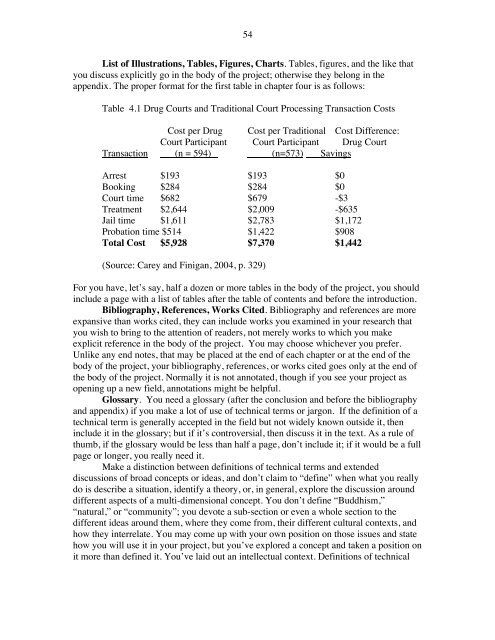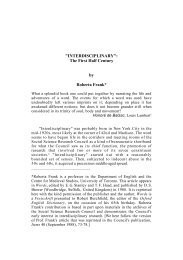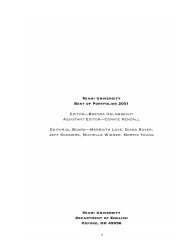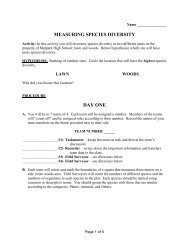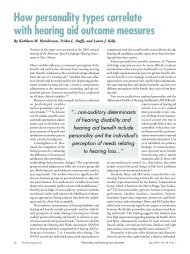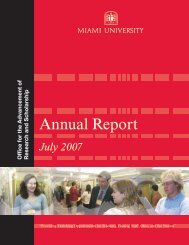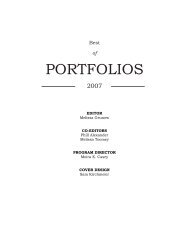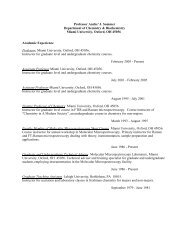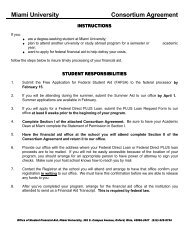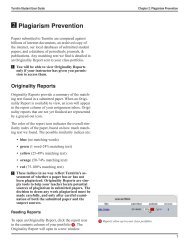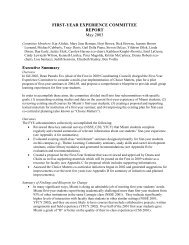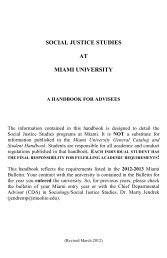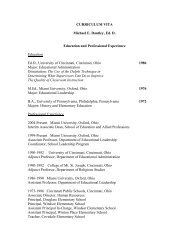Interdisciplinary Research Manual - Units.muohio.edu
Interdisciplinary Research Manual - Units.muohio.edu
Interdisciplinary Research Manual - Units.muohio.edu
You also want an ePaper? Increase the reach of your titles
YUMPU automatically turns print PDFs into web optimized ePapers that Google loves.
54<br />
List of Illustrations, Tables, Figures, Charts. Tables, figures, and the like that<br />
you discuss explicitly go in the body of the project; otherwise they belong in the<br />
appendix. The proper format for the first table in chapter four is as follows:<br />
Table 4.1 Drug Courts and Traditional Court Processing Transaction Costs<br />
Cost per Drug Cost per Traditional Cost Difference:<br />
Court Participant Court Participant Drug Court<br />
Transaction (n = 594) (n=573) Savings<br />
Arrest $193 $193 $0<br />
Booking $284 $284 $0<br />
Court time $682 $679 -$3<br />
Treatment $2,644 $2,009 -$635<br />
Jail time $1,611 $2,783 $1,172<br />
Probation time $514 $1,422 $908<br />
Total Cost $5,928 $7,370 $1,442<br />
(Source: Carey and Finigan, 2004, p. 329)<br />
For you have, let’s say, half a dozen or more tables in the body of the project, you should<br />
include a page with a list of tables after the table of contents and before the introduction.<br />
Bibliography, References, Works Cited. Bibliography and references are more<br />
expansive than works cited, they can include works you examined in your research that<br />
you wish to bring to the attention of readers, not merely works to which you make<br />
explicit reference in the body of the project. You may choose whichever you prefer.<br />
Unlike any end notes, that may be placed at the end of each chapter or at the end of the<br />
body of the project, your bibliography, references, or works cited goes only at the end of<br />
the body of the project. Normally it is not annotated, though if you see your project as<br />
opening up a new field, annotations might be helpful.<br />
Glossary. You need a glossary (after the conclusion and before the bibliography<br />
and appendix) if you make a lot of use of technical terms or jargon. If the definition of a<br />
technical term is generally accepted in the field but not widely known outside it, then<br />
include it in the glossary; but if it’s controversial, then discuss it in the text. As a rule of<br />
thumb, if the glossary would be less than half a page, don’t include it; if it would be a full<br />
page or longer, you really need it.<br />
Make a distinction between definitions of technical terms and extended<br />
discussions of broad concepts or ideas, and don’t claim to “define” when what you really<br />
do is describe a situation, identify a theory, or, in general, explore the discussion around<br />
different aspects of a multi-dimensional concept. You don’t define “Buddhism,”<br />
“natural,” or “community”; you devote a sub-section or even a whole section to the<br />
different ideas around them, where they come from, their different cultural contexts, and<br />
how they interrelate. You may come up with your own position on those issues and state<br />
how you will use it in your project, but you’ve explored a concept and taken a position on<br />
it more than defined it. You’ve laid out an intellectual context. Definitions of technical


